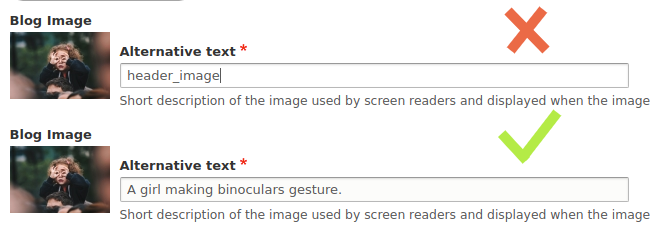
10 SEO tips – make Google love your Drupal-based website
So, you already have a Drupal-based website. Great! What now? Well, you should definitely start promoting it! Some claim that nothing is ever lost on the internet; however, it won’t hurt to help your potential customers find your website using some SEO tricks. What should you do to get your website to come out of the depths of Google search results right to the first page? The following ten elements are indispensable for any website, which aims to be included high in search results.
1. H1 heading – website title tag
As the name suggests, it’s the real number one – it stores information for users (and search engines) about the topic of the subpage. It is visible to the user in the form of a title in a blog article, or a name of an item or service on a product page, and because of that, it needs to be understandable to your potential customer. It should also contain some keywords.
Out of the box, Drupal requires the author of an item to include a title and makes it easy to edit it at a later time; however, there is still some room for error, for example, if the title was never actually included in the project.
This can happen when the main page or landing pages consist of several sections or blocks. When the first thing your visitor sees on your website is a text banner, make sure that its text exactly matches the H1 heading.
2. Title tag
Unlike H1, the content of the title tag is visible as the browser tab name and in search results, where it is displayed as the title of a given result – this is the large blue text at the top of the search result. In the vast majority of cases, H1 headers and Title tags are similar.
In the case of Drupal, the Metatags module enables you to set up titles in such a way that the Title is copied directly from H1 by default, but it can be edited manually, should the need ever arise. For example, if your H1 is longer than the commonly suggested 50-60 characters, you can shorten it for SEO purposes using a Title tag.
3. Description tag
The third part of the tag triumvirate – the three HTML tags of the greatest importance for your website. It’s never an easy task to describe a website in just a few dozen characters in the title, which is why search engines display a longer description, which is taken directly from the Description tag.
However, letting the search engine fill the field automatically based on other fields of the website is hardly the best way to show what the website is really about. The Metatags module mentioned above enables you to edit this field as well, which solves this issue.
To further optimise your website in terms of SEO, make sure that H1, Description and Title tags contain similar keywords. By doing so, you will make sure that neither search engine robots, nor users will have any doubts concerning the content on your website.

4. HTTPS
Your website should use the HTTPS protocol, and all links using HTTP should redirect to HTTPS. Why? Security, of course. Websites, which don’t use the secure protocol are considered inferior to those, which use encrypted connections, in a bid to motivate website administrators to take care of their users’ security. Make sure that your website does not scare the visitors away with security issue warnings, and they will be much more likely to trust you.
In Drupal, HTTPS is fully supported and using it should not be any problem at all – just make sure that your server is properly configured.
5. Robots.txt
The main directory of your website should have a robots.txt file with proper content – a file used to inform website robots as to how they should index your website.
Drupal supports robots.txt file out of the box, and by default, it is configured in such a way that administrative subpages are not indexed. The only thing you will need to add manually is a link to the site map, which is discussed in more detail below.
6. Site map
Search engines use site maps to index all the pages making up a given website, which allows them to include content that was published fairly recently.
In the case of Drupal, the Sitemap module allows you to manage the content of your site map effectively. The system will automatically update the map if you set rules for different content sets and make changes concerning selected subpages.
7. ALT attribute
Every image and graphic element used on the website should not only have an ALT attribute, but it should also be described in a few words. This may sometimes seem to be counterintuitive and complicated, especially when it comes to graphic elements illustrating more complex or abstract concepts; however, you can also take this great opportunity to saturate the site with even more keywords. By doing so, you will provide search engines with information about the content of the image and – more importantly – you will also help people with visual impairments to use and understand your website. The software used by such people to read the content of various websites detects and reads aloud the descriptions contained in the ALT attribute.

Drupal enables you to add the ALT attribute when you are adding a picture or a graphic element. The best way to go about it is to make this a mandatory thing – by doing so; you will make sure that your editors won’t forget about it and won’t have to go back and do this in future.
8. URLs
Plan your website’s structure in advance and make sure that all the product links are as user-friendly as possible – this will also make them SEO friendly.
What does it mean for the link to be user-friendly?
- It means that it’s readable to the user.
- It may contain a keyword.
- The words are separated with hyphens.
- All the included words are in the language of the page.
- The link should not contain any content from saved user session or other sources.
Just take a look at the URL of this article! At Droptica, we are using the Pathauto module, which automatically creates user-friendly URLs for every path in the system and enables us to edit them manually if needed.
9. Redirections
There are some situations in which you should use redirections on your website. From the standpoint of SEO, the most important of them are:
- Redirections to the actual content, if the URL linking to it has been changed.
- Redirections to new locations related to content that has been deleted.
- Avoiding duplicated content.
Drupal offers a number of features, which are useful in all of these cases, such as creating automatic redirections of URLs containing uppercase letters to their lowercase counterparts. In the previous section, we mentioned a module that enables you to create user-friendly URLs. Redirect is yet another module that is useful for handling redirections – it allows you to create redirections to pages without a forward-slash (“/”) from pages with a slash at the end of their URLs.
10. Mobile-friendly approach
More than half of traffic on the internet is generated by users browsing using mobile devices, no wonder why search engines started prioritising mobile-friendliness as an important indicator of whether a website is relevant to the user.
Thanks to its theme engine, Drupal enables you to create responsive websites.
Summary
In this article, we shared ten important tips, which you can apply to help your Drupal-based website successfully compete for the top positions in search engine results. However, this is the absolute minimum. If you want to achieve even better results, take a look at our e-book about SEO and Drupal. In addition to numerous tips and extensive explanations, you will also find a handy checklist to help you carry out an SEO audit on your own.
You can also take advantage of our services! We will carry out an in-depth professional SEO audit of your Drupal-based website and point out how you can develop it further to make it more visible in search engine results.








